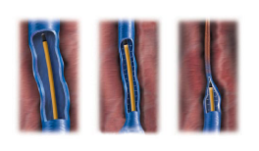Radiofrequency Thermal Ablation (RFA) has been a minimally invasive alternative to traditional vein stripping surgery and laser treatments since 2008. During the procedure, diseased veins are closed off by inserting a catheter into a vein and heating the vein wall using temperature-controlled RF energy. Heating the vein wall causes collagen in the wall to shrink and the vein to close. After the vein is sealed shut, blood then naturally re-routes to healthy veins. At Performance Vein Institute of Los Alamitos, we use Medtronic's ClosureFast system (also known as VNUS Closure and Venefit Procedure).
Since valves can't be repaired, the only alternative is to re-route blood flow through healthy veins. Traditionally, this has been done by surgically removing (stripping) the troublesome vein from your leg. RFA provides a less invasive alternative to vein stripping by simply closing the problem vein instead. Once the diseased vein is closed, other healthy veins take over and empty blood from your legs.
During a stripping procedure, the surgeon makes an incision in the groin and ties off the vein, after which a stripper tool is threaded through the saphenous vein and used to pull the vein out of your leg through a second incision just above your calf.
With RFA there is no need for groin surgery. Instead, the vein remains in place and is closed using a special catheter inserted through a small puncture. This may eliminate the bruising and pain often associated with vein stripping (i.e., that may result from the tearing of side branch veins while the saphenous vein is pulled out). Vein stripping is usually performed in an operating room, under a general anesthetic, while RFA is performed on an outpatient basis, typically using local or regional anesthesia.
Three randomized trials of the ClosureFast procedure vs. vein stripping, including the most recent multi-center comparative trial, show very similar results. In the multi-center comparative trial, the ClosureFast procedure was superior to vein stripping in every statistically significant outcome. In the study, 80.5% of patients treated with the ClosureFast procedure returned to normal activities within one day, versus 46.9% of patients who underwent vein stripping. Also, ClosureFast patients returned to work 7.7 days sooner than surgical patients. Patients treated with the ClosureFast procedure had less postoperative pain, less bruising, faster recovery and fewer overall adverse events.1
Each RFA (ClosureFast) session takes approximately 30-40 minutes to complete.
Patients report feeling little, if any pain during the procedure.
When being treated on an outpatient basis in our venous suite, patients are given anesthetic that is administered locally.
Many patients can resume normal activities immediately. For a few weeks following the treatment, your doctor may recommend a regular walking regimen and suggest you refrain from very strenuous activities (heavy lifting, for example) or prolonged periods of standing.
Most patients report a noticeable improvement in their symptoms within 1-2 weeks following the procedure.
Patients report minimal to no scarring, bruising, or swelling following the ClosureFast procedure.
As with any medical intervention, potential risks and complications exist with RFA. All patients should consult their doctors to determine if their conditions present any special risks. Your physician will review potential complications of the procedure at the consultation. Potential complications can include: vessel perforation, thrombosis, pulmonary embolism, phlebitis, hematoma, infection, paresthesia (numbness or tingling) and/or skin burn.
Only a physician call tell you if RFA is a viable option for your venous problems. Experience has shown that many patients with superficial venous reflux disease can be succesfully treated using RFA.
1 Lurie F, Creton D, Eklof B, Kabnick LS, Kistner RL, Pichot O, et al. Prospective randomized study of endovenous radiofrequency obliteration (Closure) versus ligation and stripping in a selected patient population (EVOLVES study). J Vasc Surg 2003;38:207-14.
2 Goldman, H. Closure of the greater saphenous vein with endo radiofrequency thermal heating of the vein wall in combination with ambulatory phlebectomy: preliminary 6-month follow-up. Dermatol Surg 2000; 26:452-456.
Link Library
This panel includes outbound links to trusted sources of medical information such as the National Health Library, Medline and American Heart Lung and Blood Institute. Links will direct you to a new browser window. Please note that all information contained at these web sites is meant for informational purposes only, and is not intended as a substitute for an actual physician visit.
Medtronic | ClosureFast Patient Information
http://medtronicendovenous.com/patients/7-1-closurefast-procedure/
National Health Library | American Heart Lung and Blood Institute - Overview, FAQs and more
http://www.nhlbi.nih.gov/health/dci/Diseases/vv/vv_all.html
National Health Library | Medline Plus
Varicose Vein Introduction and Associated Links







 Effective August 30, 2017: Now welcoming patients at our new location, 5300 Katella Avenue in Los Alamitos.
Effective August 30, 2017: Now welcoming patients at our new location, 5300 Katella Avenue in Los Alamitos. 

